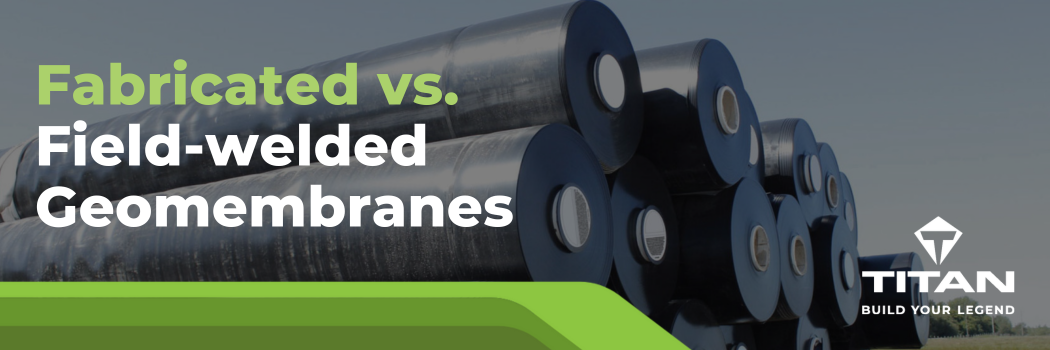When specifying geomembranes for environmental containment and infrastructure projects, the choice between fabricated geomembranes and field-welded geomembranes plays a significant role in structural performance and longevity.
Traditionally, heavy and rigid geomembranes, such as high-density polyethylene (HDPE), are specified for applications such as environmental lining, secondary containment, spill containment berms, and more. Although HDPE is often the preferred geomembrane for its durability and superior chemical resistance, it’s too rigid to fabricate. This means all HDPE geomembranes are field-welded.
Advances in manufacturing have improved the quality standards of fabricated geomembranes, enabling them to outperform field-welded geomembranes in many applications.
That said, there are certain instances where field-welded geomembranes are a suitable option:
- Small-scale projects with manageable site conditions that are quick to install
- Applications that require extreme, long-term chemical resistance
Before specifying a traditional geomembrane for your next environmental containment project, consider the following 7 reasons fabricated geomembranes can provide optimal performance and significant cost-savings.
7 Reasons to Choose Geomembrane Fabrication Over Field-Welding
1: Controlled Conditions
Fabricated geomembranes are welded in factory conditions where wind and dirt can be managed. This controlled setting eliminates the variability associated with field conditions and ensures that the geomembranes are produced consistently to meet specified standards.
2: Consistent Temperature
In the factory, welders operate in an environment with a constant temperature. This stability is crucial because welding geomembranes requires precise temperature control to achieve optimal fusion between the geomembrane sheets. In contrast, in the field, welders must adapt to changing weather conditions, changes in cloud cover, and sunlight as the sheet heats up, which can affect the welding process.
3: Hard Subgrade
Fabricated geomembranes are installed on solid concrete floors. This stable surface provides a secure foundation for welding equipment, ensuring that the welding process remains consistent and accurate. The firm subgrade produces higher strength seams in both shear strength and peel strength. It also minimizes the risk of distortion or irregularities in the seams.
4: Efficient Installation & Reduced Field Seaming
Fabricated seams save significant time during installation compared to field-welded seams. Once delivered to the job site, a fabricated geomembrane panel is easy to unload and install. Panels can be fabricated to almost 1 acre in size, then unrolled and pulled across the coverage area. These efficiencies reduce labour costs and project timelines. For example, seams on a 15-panel fabricated geomembrane would take about half an hour, compared to a full day in the field. This makes fabricated geomembranes an attractive option for large-scale projects with strict budget and time constraints.
5: Higher Quality Seams
Factory-welded seams are often of higher quality in terms of both shear strength (resistance to forces parallel to the seam) and peel strength (resistance to forces perpendicular to the seam). The controlled conditions in the factory result in consistently strong and durable seams, reducing the risk of seam failure over time.
6: Custom Panel Sizes
Fabricated geomembranes offer flexibility in panel sizes, with the ability to customize panels to match the specific requirements of a project. This customization is beneficial when covering large areas, as it minimizes seams and simplifies installation while maximizing efficiency.
7: Quality Control and Assurance
Factory-welded geomembranes benefit from robust quality control and quality assurance processes. Manufacturers can implement rigorous testing and inspection protocols on a concentrated scale, ensuring that each geomembrane panel meets quality standards. This approach enhances reliability and minimizes the potential for defects that may occur with field-welded geomembranes due to varying conditions and workmanship.
Seam Testing and Inspection
Testing is essential for all geomembrane liner seams, regardless of seam type. For small projects using fabricated liners, inspections can usually be completed on the same day. Larger projects with multiple field seams may require an extra day of inspections, increasing costs. The Fabricated Geomembrane Institute (FGI) has established guidelines for conducting seam tests.
There are two types of seam testing:
- Pre- and post-qualification seam testing. Pre- and post-qualification tests involve peel and shear strength on trial seams, at least six feet long, using the same equipment and conditions as production welding.
- Production seam testing. To maintain the integrity of the seams throughout the entire installation process, production seam testing should occur at least once per shift change or every four hours, following the same criteria as pre- and post-qualification testing. Testing is also necessary when welding is interrupted due to equipment changes or breaks to maintain seam quality.
Choosing the Right Product: Site-Specific Installation
The correct installation of a geomembrane liner is essential for the success of an environmental containment application, and the quality of seams in the selected liner directly impacts its performance.
Overall, fabricated geomembranes offer contractors and project managers a level of assurance that field-welded geomembranes cannot, thanks to factory-controlled conditions that allow for superior seam welding.
Field-welded geomembranes are still a suitable option for specific applications that require an extremely chemically resistant liner such as HDPE, or smaller-scale projects that are quicker to install and have less strict time constraints. Thick geomembranes can offer better protection and longevity but may also be less flexible and can be more challenging to install.
Ultimately, the choice between a fabricated geomembrane or a field-welded geomembrane depends on the project’s unique demands, site conditions, budget considerations, and the expertise of the installation team.
Comprehensive Geosynthetic Fabrication Service
Equipped with the latest technology, Titan’s in-house Geosynthetics Fabrication Division follows the highest quality assurance standards and specializes in custom fabrication of geomembrane panels, geotextile panels, and specialty products for a wide variety of applications.
Our team caters to unique project needs with a range of suitable material options to deliver meticulously fabricated products.
Learn more about Titan’s Geosynthetics Fabrication Division here.
Let’s Work Together
If you’re interested in connecting about a current or future project, simply give us a call or request a consultation using the form below.
If you already know your project requirements, click here to get a quote!
Our top priority is your project success.

